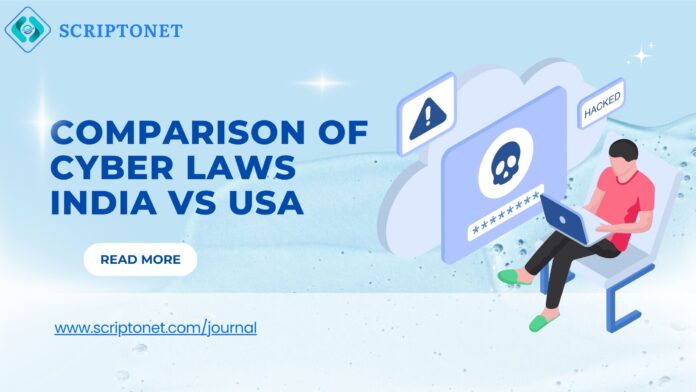Introduction
Comparison of Cyber Laws India vs USA are both aimed at protecting individuals & organizations from cybercrime, but they differ in their scope & approach. India’s Information Technology Act, 2000 (as amended) is the primary legislation governing cybercrime, covering areas like hacking, data theft & online fraud. It also addresses issues like digital signatures & e-commerce. The USA, on the other hand, has a more fragmented approach with various federal & state laws addressing specific aspects of cybercrime, such as the Computer Fraud & Abuse Act, the Digital Millennium Copyright Act & the Electronic Communications Privacy Act.
While both countries have laws to protect personal data, the USA has a stronger emphasis on individual privacy rights, with laws like the California Consumer Privacy Act (CCPA) granting consumers greater control over their data. India’s data protection framework is still evolving, with the recent Digital Personal Data Protection Act, 2023, seeking to establish a comprehensive framework for data protection. Both countries also address cybersecurity through various regulations & initiatives, with the USA having a more mature & comprehensive cybersecurity framework compared to India.
Legal Framework & Key Legislations
India’s legal framework for cyber activities is primarily anchored by the Information Technology Act, 2000 (IT Act). This comprehensive legislation serves as the cornerstone of India’s cyber law, addressing a broad spectrum of issues ranging from cybercrime, such as hacking, data theft & online fraud, to data protection & electronic commerce. The IT Act provides the legal framework for digital signatures & online transactions, recognizing the growing importance of e-commerce in the Indian economy.
Furthermore, it has been amended & supplemented by various rules & regulations over the years to keep pace with the rapidly evolving digital landscape. A notable example is the IT (Intermediary Guidelines & Digital Media Ethics Code) Rules, 2021, which focuses on regulating social media platforms & digital content, reflecting India’s efforts to address concerns related to online speech, misinformation & data privacy in the context of social media. This centralized approach, with the IT Act as the overarching legislation, provides a unified framework for addressing cyber-related legal issues in India.
In contrast, the United States adopts a more fragmented & sector-specific approach to regulating cyber activities. Instead of a single, comprehensive law like India’s IT Act, the US legal landscape comprises a complex web of federal & state laws that address specific aspects of cyber activity. Important federal laws include the Children’s Online Privacy Protection Act (COPPA), which protects children’s online privacy, the Electronic Communications Privacy Act (ECPA), which protects the privacy of electronic communications, and the Computer Fraud & Abuse Act (CFAA), which makes a number of computer-related offenses, such as hacking and unauthorized access, illegal.
Beyond these federal laws, individual states also play a significant role in regulating cybersecurity & data privacy, enacting their own laws related to data breach notification, cybersecurity standards & consumer privacy. This decentralized system, with its patchwork of federal & state regulations, allows for tailored approaches to specific cyber issues but can also create challenges in terms of consistency & enforceability across different jurisdictions.
Privacy & Data Protection
Data protection laws in India & the USA present a study in contrasting approaches. India’s Digital Personal Data Protection Act, 2023 (DPDP Act), establishes a framework focused on consent-based data processing, empowering individuals with control over their personal information. It mandates obligations for Data Fiduciaries & imposes penalties for violations, marking a significant step in India’s data protection journey.
However, a key point of discussion surrounds the absence of a strong, independent regulatory body comparable to the EU’s GDPR model. This raises concerns about the Act’s enforcement capabilities & its ultimate effectiveness in safeguarding individual privacy rights. The DPDP Act represents a move towards a more comprehensive data protection regime in India, though its practical implementation & the efficacy of its enforcement mechanisms remain to be seen.
The USA, on the other hand, lacks a single, comprehensive federal data protection law. Its approach is characterized by a sector-specific mosaic of federal & state regulations. California’s Consumer Privacy Act (CCPA) stands out as a leading example of state-level legislation, granting California residents specific rights regarding their personal data, including the right to know what information is being collected, the right to delete their data & the right to opt out of the sale of their personal information. Beyond state-level initiatives, various federal laws, such as the Health Insurance Portability & Accountability Act (HIPAA), govern data protection within specific sectors, like healthcare, addressing the unique privacy concerns within those industries.
This fragmented, sector-specific approach, while allowing for tailored regulations, can create inconsistencies & complexities, potentially hindering the establishment of a unified & comprehensive data protection standard across the nation. The lack of a single federal law also raises questions about the balance between individual privacy rights & business interests, a debate that continues to shape the evolution of data protection law in the USA.
Cybercrime & Enforcement
In India, cybercrime is addressed through a combination of the Information Technology Act, 2000 (IT Act) & the Indian Penal Code (IPC). The IT Act specifically deals with cyber offenses, while the IPC provides a broader framework for criminal law that can be applied to cybercrimes where relevant. Various agencies, including specialized Cyber Crime Cells & the Indian Computer Emergency Response Team (CERT-In), play crucial roles in investigating & responding to cyber threats.
CERT-In acts as the national nodal agency for cybersecurity incidents, while Cyber Crime Cells at the state & national levels are responsible for investigating specific cybercrime cases. Despite these institutional mechanisms, enforcement often faces challenges due to bureaucratic hurdles, a lack of specialized training for law enforcement personnel & the sheer volume of cybercrime cases. This can lead to delays in investigations & prosecutions, hindering effective deterrence.
The United States boasts a more robust & technologically advanced cybercrime enforcement system. Several federal agencies are actively involved in investigating & prosecuting cybercrimes, including the Federal Bureau of Investigation (FBI), the Cybersecurity & Infrastructure Security Agency (CISA) & the Secret Service. The FBI plays a leading role in investigating complex cybercrime cases, while CISA focuses on enhancing cybersecurity infrastructure & providing incident response support. The Secret Service looks into cybercrimes involving money fraud because of its experience with financial crimes.
This multi-agency approach, coupled with well-defined legal frameworks & substantial investment in technological infrastructure, contributes to a more effective enforcement system. The US also benefits from greater international cooperation in tackling cybercrime, facilitating cross-border investigations & information sharing. However, even with these advantages, the rapidly evolving nature of cybercrime & the increasing sophistication of cybercriminals continue to pose significant challenges to law enforcement efforts in the US.
Conclusion
In conclusion, while both India & the USA have established legal frameworks to address the growing challenges of cybercrime & data protection, their approaches differ significantly. India relies on a centralized legislative framework primarily built around the IT Act, supplemented by more recent legislation like the DPDP Act. While this approach offers a unified structure, enforcement challenges & the evolving nature of cyber threats necessitate continuous adaptation & improvement.
The USA, on the other hand, employs a more decentralized, sector-specific model, with a patchwork of federal & state laws addressing specific aspects of cyber activity. This approach allows for tailored regulations but can also create complexities in ensuring consistent protection & enforcement. Both nations grapple with the rapid pace of technological advancements & the increasing sophistication of cybercriminals.
The effectiveness of their respective legal frameworks & enforcement mechanisms will depend on their ability to adapt to these evolving challenges, invest in technological infrastructure & training & foster greater international cooperation in the fight against cybercrime. Ultimately, both India & the USA recognize the critical importance of safeguarding their digital ecosystems & are continually striving to enhance their cyber legal landscapes to protect individuals, organizations & national security in the digital age.
Frequently Asked Questions (FAQ)
What is the primary law governing cyber activities in India & what are its key components?
The Information Technology Act, 2000 (IT Act), as amended, is the primary legislation. It covers cybercrime, data protection, electronic commerce & digital signatures & has been supplemented by rules like the IT (Intermediary Guidelines & Digital Media Ethics Code) Rules, 2021.
How does the US approach cyber law & data protection compared to India?
The US follows a decentralized, sector-specific approach with multiple federal & state laws (example: CFAA, ECPA, CCPA), while India utilizes a more centralized framework with the IT Act & DPDP Act as its core. The US has a stronger emphasis on individual privacy rights with laws like CCPA.
What are the main challenges faced by both India & the USA in enforcing cyber laws?
Both countries grapple with the rapidly evolving nature of cybercrime, the increasing sophistication of cybercriminals & the need for continuous adaptation of their legal frameworks. India faces additional challenges related to bureaucratic hurdles & resource constraints, while the US faces complexities arising from its decentralized system.
How does India’s data protection framework differ from the US approach?
India’s DPDP Act focuses on consent-based data processing & penalties for violations, though concerns remain about the strength of its regulatory body. The US lacks a single federal law, relying instead on a mix of state laws (example: CCPA) & sectoral laws (example: HIPAA), leading to a less unified approach.
What are some key areas where international cooperation is crucial in addressing cybercrime?
International cooperation is essential for cross-border investigations, information sharing about cyber threats & criminal actors, harmonization of legal frameworks & capacity building to combat cybercrime effectively on a global scale.


